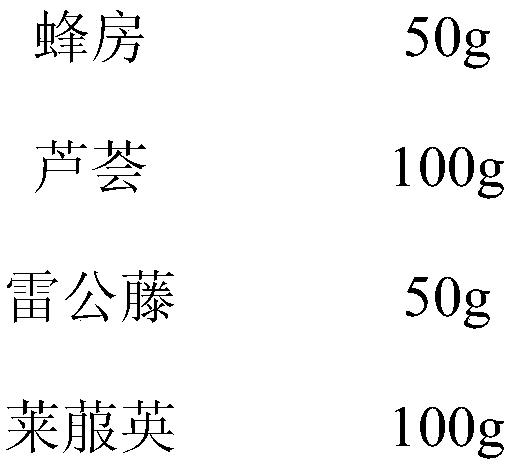Leaf-roller killing agent without polluting environment
A technology that pollutes the environment and spinoderma, applied in the direction of insecticides, biocides, animal repellents, etc., can solve the problems of pest resistance and drug resistance differences, and the insecticidal effect is prone to drug-resistant pests, etc., to achieve No environmental toxicity, less drug resistance, less impact
- Summary
- Abstract
- Description
- Claims
- Application Information
AI Technical Summary
Problems solved by technology
Method used
Image
Examples
Embodiment 1
[0023] This example provides a non-polluting environment-friendly extermination agent for the spider moth, including hive extract, aloe extract, tripterygium extract, radish extract, houttuynia extract, chamaejasma extract, and small rejuvenation extract Extract, Jade Hibiscus Extract, Green Fruit Extract and Osthole in the following quantities:
[0024]
[0025]
[0026] Its preparation method: decoct the hive, aloe, and tripterygium wilfordii with water twice, each time for 2 hours, combine the decoction, add ethanol to filter and concentrate, add 3 times the amount of water, fully stir, refrigerate for 48 hours, filter, and the filtrate is concentrated under reduced pressure When the relative density is about 1.15, the medicinal solution is set aside; radish, houttuynia cordata, chamaejasma chamaeba, small reincarnation, jade hibiscus, and green fruit are decocted twice, each time for 1 hour, combined decoction, filtered, concentrated filtrate, put Cool, add ethanol t...
Embodiment 2
[0029] This example verifies the killing rate of the medicinal composition against the extrinsic moth compared with common insecticides on the market.
[0030] Select the common insecticides on the market: P. lilacinus water agent, nematicide, special root thread agent, and thiamethoxam insecticide.
[0031] Grouping according to different insecticides, each group prepares 1,000 Trichorrha moths in the three stages of eggs, larvae, and adults respectively, and then uses insecticides on the Trichorrha moths in each stage, and tests each group to kill Insecticide kill rate, as shown in the table below:
[0032] Table 1 The killing effect of insecticides on Spodoptera moth
[0033]
[0034] It can be seen from the above table that each group of insecticides has the highest killing rate on the larval state of the Spodoptera moth, and this product has the best insecticidal effect, and the killing effect is remarkable, even the most difficult to kill eggs are also better killed ...
Embodiment 3
[0036] This example verifies the killing rate of the pharmaceutical composition on various pests.
[0037] Select 10,000 scarabs, beetles, leafhoppers, borers, pear psyllids, scale insects, spodoptera, mole crickets, vetch, and root-knot nematodes, and group them respectively, and use the medicines prepared in Example 1 to make medicines of the same concentration. liquid, spray the pests of each group respectively, and after 1 hour, check the killing rate of various pests, the results are shown in the following table:
[0038] Table 2 The killing effect of the drug on various pests
[0039] group
[0040] As can be seen from the above table, the medicine prepared in Example 1 has a good killing effect only on Spodoptera moth, and has a very limited killing effect on other pests. This proves that this product is highly targeted and can only be used to kill insects. Used for the extermination of Spodoptera moth.
PUM
 Login to View More
Login to View More Abstract
Description
Claims
Application Information
 Login to View More
Login to View More - R&D
- Intellectual Property
- Life Sciences
- Materials
- Tech Scout
- Unparalleled Data Quality
- Higher Quality Content
- 60% Fewer Hallucinations
Browse by: Latest US Patents, China's latest patents, Technical Efficacy Thesaurus, Application Domain, Technology Topic, Popular Technical Reports.
© 2025 PatSnap. All rights reserved.Legal|Privacy policy|Modern Slavery Act Transparency Statement|Sitemap|About US| Contact US: help@patsnap.com



